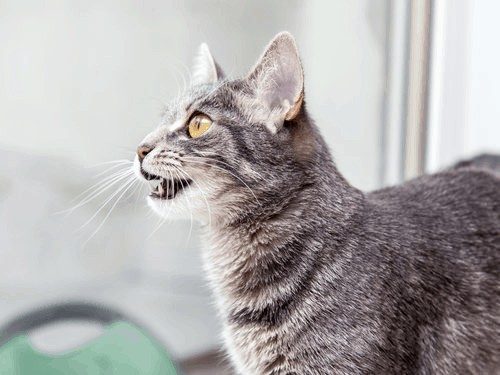Watching your cat have a seizure is difficult. It is a scary time for both you and your cat. This is especially true the first couple of times as most owners have never seen a cat have a seizure.
What is a seizure?
Seizures are caused by changes in the electrical activity of the brain and most last a few seconds to a few minutes but some last longer.

Seizures present as sudden fits of uncontrollable movement that can include twitching, shaking, and/or muscle spasms. Your cat can lose consciousness during a seizure, drool, vomit, urinate or defecate. Other signs of seizures in cats include uncontrolled running around the house, up the curtains, over the furniture, etc.
Different Types of Seizures
There are two types of seizures your cat can have: focal and generalized.
- Focal or partial seizures only affect part of the brain. Only one side of your cat’s body will have abnormal movement. For example, your cat may move their left leg(s) strangely or their left eye, or lips or ear may twitch. Other signs of focal seizures include tail chasing, limb chewing, aggression, and strange behavior as if your cat were chewing imaginary gum or chattering with their mouths. Focal seizures are more common in cats but can progress to the generalized form.
- Generalized seizures affect the entire brain and thus both sides of the body. They result in loss of consciousness; sudden jerking of the neck, head or body; urination; defecation; falling to one side; vocalization; vomiting; and salivation. Your cat’s legs can be stiff and difficult to bend or your cat may constantly move their legs as if they were paddling or swimming on their side.
Recognizing Seizures in your Cat
Your cat may act unusual hours to days before a seizure. This includes increased nervousness, attention-seeking or avoidance, and head-turning. Be on the lookout for these behaviors as they serve as warning signs of an oncoming seizure.
During the seizure, which usually lasts seconds to minutes, your cat may “stare off into space” and appear mentally not there. Afterward, it will take some time for them to go back to normal. This post-seizure period (post ictal) can last up to 24-48 hours. During this time, your cat may show signs of hyperactivity, pacing, circling, head pressing, and other changes in behavior.
Seizures tend to occur when there are sudden changes in brain activity such as when a cat is sleeping, waking, excited, or around feeding time. Paying close attention to your cat during these times will better help you identify a seizure.
Recurring Seizures and Epilepsy
A seizure can be a one-time event or repeated over time. Repeated seizures are called epilepsy. If your cat has epilepsy, their seizures may occur at regular intervals such as every five days or every other month. There also may be no pattern to how often your cat’s seizures happen. Between seizures and after the post-seizure period, your cat will behave normally with no obvious signs of illness unless they have another disease going on.
What Causes Seizures?
One-time seizures can be caused by toxins, trauma, metabolic disease, low blood sugar, or triggering stimuli such as lights or high-pitched sounds. Metabolic issues are often linked to other diseases of the liver, kidney, or thyroid. These single seizures can progress to multiple seizures over time if the underlying cause is not treated.
Multiple seizures or epilepsy are either primary or acquired. Primary epilepsy has a known or suspected genetic basis. Acquired epilepsy does not; it is caused by factors that affect the brain. These factors can directly affect the brain and include head trauma, infectious diseases such as fungal or protozoal as well as cancer and abnormal brain development.
Sometimes your veterinarian will not be able to determine what is causing your cat’s seizures and will call them idiopathic. Idiopathic means there is not a known cause. These types of seizures, however, are not common in cats but can occur.
What Do you Do if your Cat is Having a Seizure?
Most seizures cats have are not medical emergencies. The most important things you can do are make sure your cat does not hurt themselves and take note of how they act. You will need to schedule an appointment with your veterinarian so it’s important to describe what happened before, during, and after the seizure as best as possible.
A video is an excellent way to do so and help your veterinarian determine what happened. During the seizure, do not touch your cat unless they are at risk of hurting themselves. If this is the case, use a thick blanket to move them as some cats become aggressive when having a seizure.
What Seizures are Emergencies?
If your cat has a seizure that lasts longer than five minutes or has more than three seizures in a row without returning to normal between them, seek immediate veterinary care. This is called status epilepticus and is a medical emergency.
If your cat has more than one seizure within a 24-hour period and acts normal between each one, this is called a cluster seizure. Cluster seizures are not usually considered to be an emergency, but if you are in doubt, see a veterinarian. It is important to address quickly as the more seizures your cat has, the more damage to brain cells may occur.
Diagnosing Seizures
A thorough history and description/record of the event are critical to diagnosis. These are important for confirming whether your cat had a seizure and if there was possible exposure to toxins. Your veterinarian will perform a physical examination of your cat and run several blood tests to rule out metabolic and infectious causes.
A neurologic exam will also be performed. If diseases outside of the brain are ruled out, further diagnostics to evaluate brain function include advanced imaging such as computed tomography (CT) and magnetic resonance imaging (MRI). Your veterinarian may refer you to a veterinary neurologist.
Treatment

Treatment of seizures depends on what caused them, how severe they are and how often they occur. If your cat is having a medical emergency, your veterinarian and veterinary team will stabilize them through use of fluid therapy, short-acting anti-convulsant drugs, and other measures to get the seizures under control.
Once your cat is stable and if possible, their underlying issue will be treated. This can be as simple as removing a toxic substance to treating serious liver or kidney issues. Some cats with seizures respond well to this approach and will not have seizures again once the underlying cause is treated.
Other cats with seizures, particularly those with epilepsy, require long-term anti-convulsant therapy. Preventing your cat from ever having another seizure in their life is often not possible; the goal of treatment is to reduce how severe their seizures are and how often they happen. Improving your cat’s seizures is done by using anti-convulsant medications, particularly phenobarbital and in other cases zonisamide.
It takes time to determine the best dose and drug for your individual cat and several adjustments are made over time to control the seizures. It is important to work closely with your veterinarian and follow the recommended treatment schedule. Seizure therapy is often a lifelong necessity.
In general, cats have fewer side effects than dogs when it comes to seizure medication. Mild common side effects occur at the start of treatment or when changes are made to their treatment. These include drowsiness, incoordination, increased appetite, and weight gain. Most of these effects are temporary so notify your veterinarian if they persist or seem severe.


